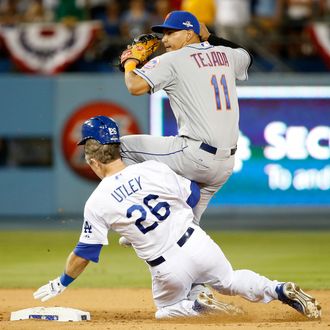
Last year, in Game 2 of the NLDS, a vicious slide by Chase Utley of the Dodgers broke the leg of Mets shortstop Rubén Tejada, causing him to miss the remainder of the playoffs. The Mets would lose that game, and Utley immediately became public enemy No. 1 in Flushing, where Mets fans were furious over what was widely seen as a dirty play. Utley was ultimately suspended for two games, but in the moment, the on-field umps ruled him safe, thanks in part to a rule book that didn’t explicitly spell out what a legal slide must look like. But as of today such a rule exists.
New for the 2016 season is rule 6.01(j), which lays out what a player can and can’t do while sliding into second with an opportunity to break up a double play. The rule states the base-runner must make a “bona fide” attempt to reach the base. (In other words, he can’t focus entirely on taking out the infielder or block the throw.) Although the runner can still initiate contact with an infielder in an otherwise legal slide, he can’t change his path to get to the fielder, or use a “roll block” to take him out.
The rule states that if a runner doesn’t engage in a “bona fide slide” and initiates contact with the fielder in order to break up a double play, he’ll be called out for interference, and the batter running to first will be out as well. But perhaps the most important part of the rule is that it states what exactly a “bona fide slide” is in such situations:
• The runner must begin his slide and make contact with the ground before he reaches the base.
• The runner must be able to reach the base with his hand or foot — and actually make an attempt to do so.
• He must make an attempt to stay on the base after completing the slide.
• And he must slide “within reach of the base without changing his pathway for the purpose of initiating contact with a fielder.”
Here’s Utley’s NLDS slide, which under the new rules is nowhere close to legal:
Technically, that slide wasn’t legal last year, either. Under the old rules, umpires did have the authority to call a runner out for interference if he “willfully and deliberately interferes with a batted ball or a fielder in the act of fielding a batted ball with the obvious intent to break up a double play.” But it was rarely enforced, as taking out infielders — sometimes in an obvious manner — had become part of the game. At the time, umpires ruled that Utley’s slide was okay, but it was later deemed otherwise by Joe Torre, the league’s discipline czar, who suspended Utley for two games.
Such slides are now also eligible to be reviewed using instant replay, but in a controversial move, so is the so-called “neighborhood play,” in which a fielder steps near (but not on) the bag while turning a double play. So even with the new rules for sliding, fielders could end up in danger, as they’ll need to touch the base on double plays or risk a challenge. Said Mets manager Terry Collins: “We’re making a slide rule that keeps you on the bag. You’ve got to be near the bag. And now we’re making a decision on the neighborhood play that you’ve got to stay on the bag. You know what that’s going to mean? Someone is going to get their clocks cleaned.”





























